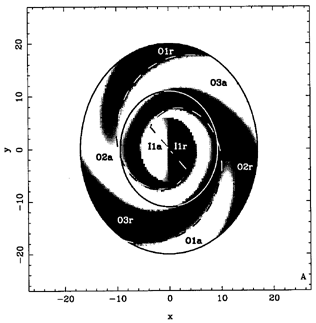
|



11.4. Pattern Speed Determination
If the dynamical theory predicts that rings should occur at Lindblad resonances, the determination of the pattern speed of the bar or spiral wave is essential to check the theory. Reciprocally, rings are then a precious tool to measure the pattern speed, when the rotation curve is known. It is, however, necessary to attribute each ring to the right resonance, and therefore to have a hint of the pattern speed order of magnitude.
The dispersion relation in spiral density wave theory (Lin & Shu 1964) tells us that the waves can exist between ILR and OLR; but there exists however a forbidden gap at CR when the Toomre Q parameter is larger than 1, and this at first oriented models of galaxies with corotation at the edge of optical disks (Roberts et al. 1975). But waves can tunnel through the gap, the presence of gas can enhance the spiral strength, and the spirals then extend up to OLR as revealed by simulations. The modal solutions also have corotation in the middle of the pattern (Bertin et al. 1989). The presence of outer rings in barred galaxies, thought to be associated with OLR, also contributed to change this view, and to put OLR at the edge of the optical disk (cf. section 11). Let us review several methods to determine the value of pattern speeds from observations (see also Elmegreen 1996).
One of the methods relies on morphology: the crossing of corotation is
supposed to correspond to a gap in luminosity for the main arms; also
interarm spurs should occur at the inner 4 / 1 resonance, with roughly an
A more straightforward method is based on the change of sign of radial streaming motions across corotation. However, many ambiguities arise when studying a strip along the minor axis. First there is no way to check that the position angle of the minor axis is right, since there are often twists in the outer regions (warps). And as soon as the strip is offset in angle, the tangential motions corrupt the analysis. García-Burillo et al. (1994) have shown through dynamical modelling that the turnover region for the radial streaming sense is very wide, and the method uncertain, when the amplitude of the wave is strong. A related method, also based on streaming motions but taking into account the ``geometric phase'' phenomenon, has been proposed by Canzian (1993). The map of residual velocities with respect to an axisymmetrical model should display a spiral pattern with one arm inside CR, and 3 arms outside (Figure 65). This has been applied to UGC 2885 and NGC 4321 (Figure 66), but also with some ambiguities.

|

| 
|
Another method, proposed by Tremaine & Weinberg (1984), is based on the assumption that the mass tracer, stars or gas, obeys a continuity equation. The method only requires the measurement of the surface brightness and the radial velocity along a strip parallel to the major axis. The continuity condition is best fulfilled for stars, but then the method requires absorption-line spectroscopy. The method has been applied to the gas in NGC 5383, but without a firm conclusion. Recently Merrifield & Kuijken (1995) have succeeded in applying the method to the stars in the barred lenticular galaxy NGC 936, yielding CR at the ends of the bar. This galaxy is a favorable case, since there is no gas which could be transformed into stars during a revolution, so the basic continuity assumption of the method is likely to be fulfilled.
Another method has been proposed by García-Burillo et al. (1993b), and consists of modelling the gas dynamical behavior in the potential derived from a red image of the galaxy. The resulting spiral structure appears to depend critically in shape and phase on the pattern speed. This has allowed the determination that CR is midway in the spiral in M51 and NGC 4321. The late-type galaxy NGC 7479, on the contrary, appears to have a bar ending well inside its CR (Sempere et al. 1995b). A dynamical model of the central Milky Way based on orbit calculations has proposed that a bar exists with an OLR at 4 kpc (Binney et al. 1991). This value is discussed further by Weinberg (1992) and Kalnajs (1991).